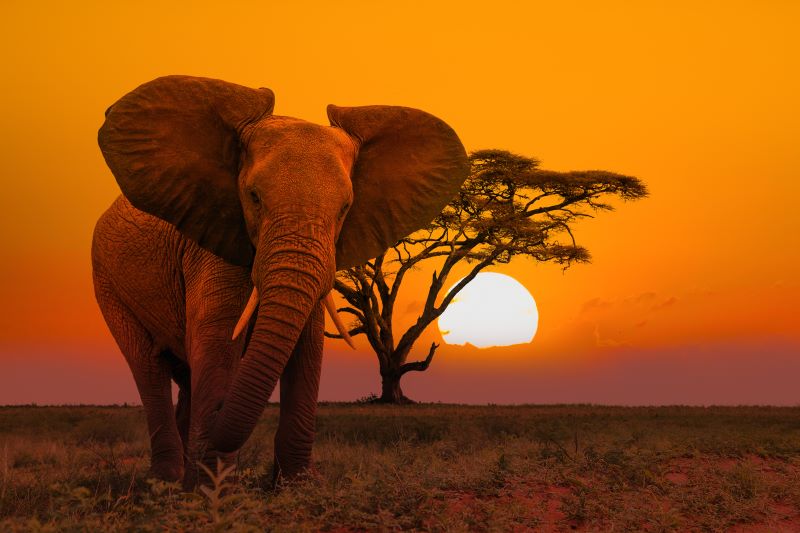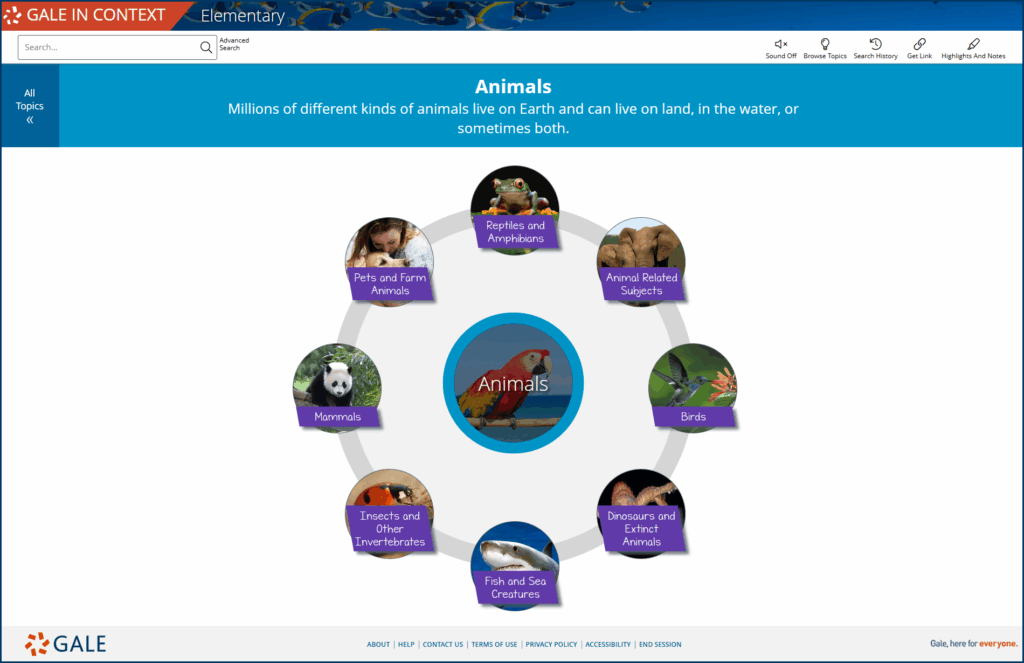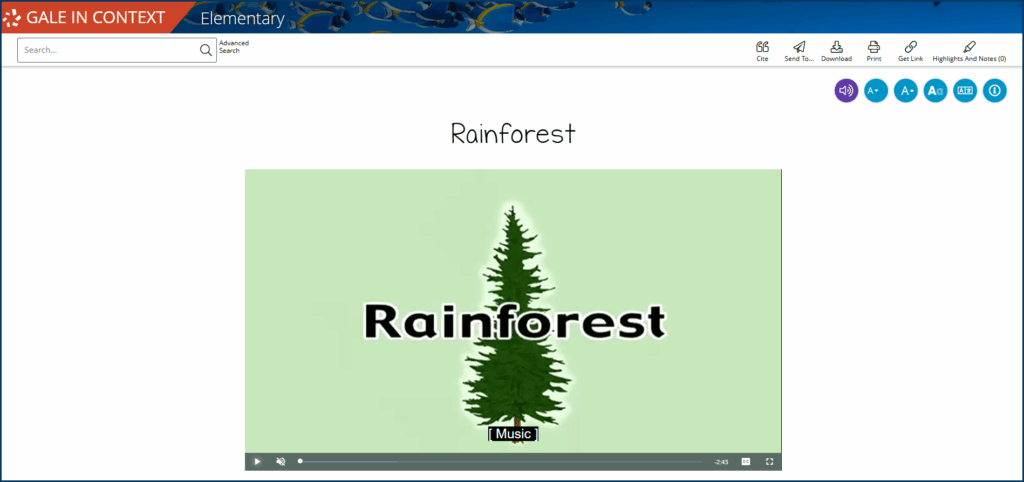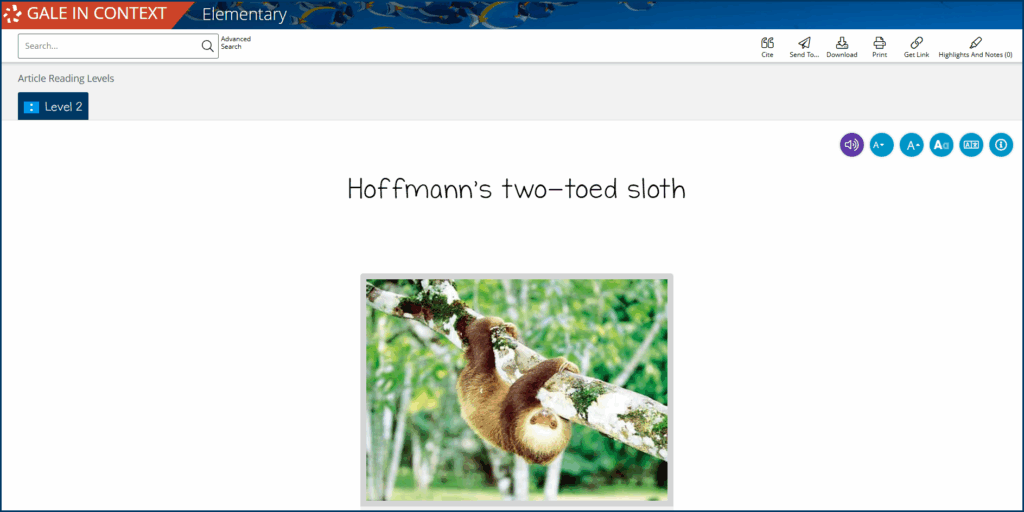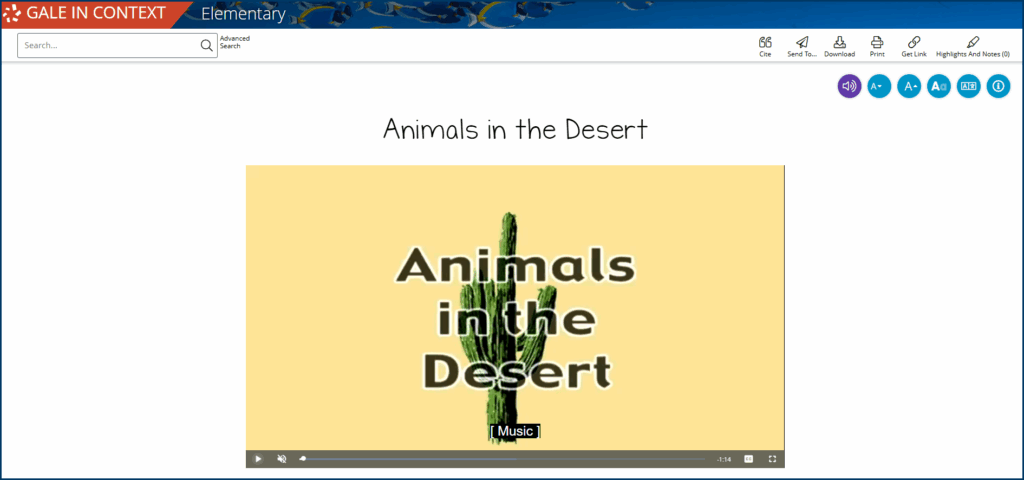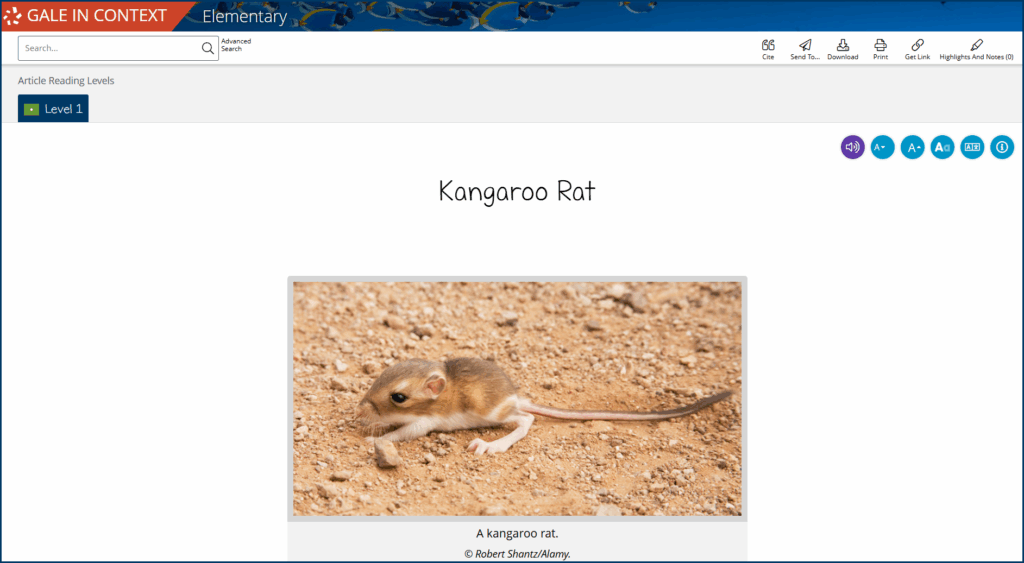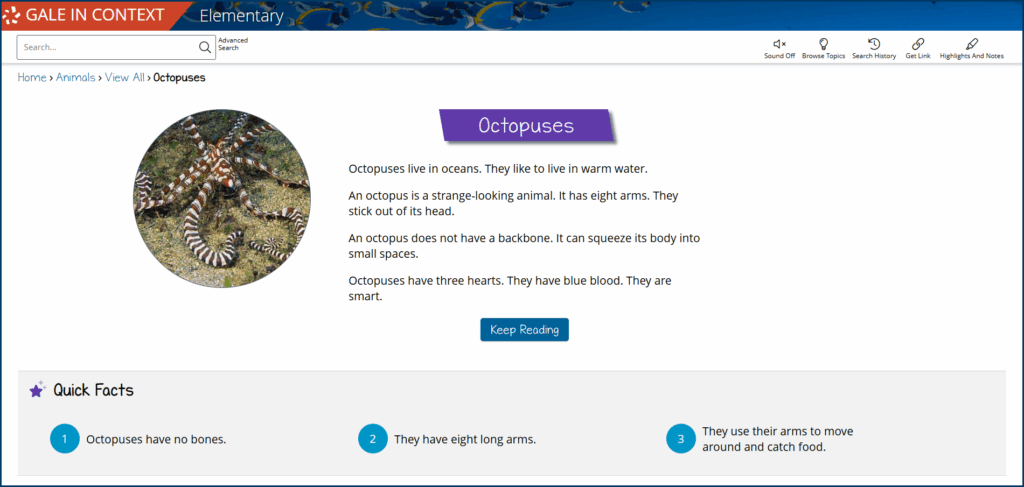World Animal Day on October 4 offers an irresistible excuse to fill your classroom with the sounds, sights, and science of the animal kingdom. But with an estimated 8.7 million species across land and sea, narrowing down which ones to feature—and doing so in a way that’s developmentally appropriate and pedagogically meaningful—can be a challenge.
To help elementary educators celebrate World Animal Day, we created a globe-spanning classroom expedition that introduces students to the astonishing ways animals adapt to the environments they call home.
We created each of the animal profiles below using resources from Gale In Context: Elementary to illustrate how the platform can spark curiosity in young learners. Resources include high-quality encyclopedia entries, vibrant images, and classroom-appropriate videos, plus fiction and nonfiction texts from trusted children’s publishers like Cricket Magazine, Highlights for Children, and National Geographic Kids. With its intuitive layout and engaging content, this learning tool supports independent exploration while giving educators the tools to guide inquiry-based learning about the wildlife we share the world with.
Amazing Animal Adaptations Across Biomes
To make the vast world of animal adaptations more accessible, we’re spotlighting three biomes: rainforest, desert, and ocean. Exploring adaptations within these environments helps students connect animals’ unique traits to the specific challenges of their habitats.
Each section focuses on two species. In addition to overviews of key information, you will find hands-on activities that invite students to observe, organize, or compare traits in context, along with open-ended discussion prompts that encourage students to think like scientists.
We have also included a short list of additional animals, perfect for fast finishers, center work, bulletin board displays, or extended research projects throughout the year.
Rainforest Biome
Rainforests cover less than 10% of the Earth’s surface, but they are home to more than half the planet’s known animal species. While the Amazon is the most famous, this complex ecosystem exists on nearly every continent, including the Congo Basin and temperate rainforests of the Pacific Northwest.
What makes them so biologically rich also makes them highly competitive. Towering trees form dense canopies that block sunlight, forcing animals to adapt to life in dim, rain-soaked layers. Each vertical zone—emergent layer, canopy, understory, and forest floor—hosts a community of uniquely specialized creatures.
Featured Animals:
- Sloth – With a metabolism that runs at half the rate of most mammals their size, sloths move slowly to conserve energy—a trait that might seem like a disadvantage. But in the high canopy, that slow movement helps them go unnoticed. Their shaggy fur supports photosynthetic algae, which tint their coats green and act as camouflage. The algae benefit too: the sloth provides a stable, moist place to grow. This is an example of mutualism, a form of symbiosis where both species benefit.
- Poison dart frog – These aposematic amphibians have brilliant, jewel-toned colors that serve as a warning to predators: they’re not safe to eat. Their toxicity comes from their diet of alkaloid-rich ants, mites, and beetles—tiny invertebrates that absorb toxins from the fungi and plants they consume. They’re so dependent on this food chain that, when raised in captivity, they lose their toxicity entirely!
Classroom Activity Idea: Create a layered rainforest mural, with students contributing animals they research using Gale In Context: Elementary. Have each student draw their animal and write a short description explaining how it has adapted to its niche, then place it in the appropriate spot on the mural.
Additional Animals to Explore:
- Harpy eagle: One of the world’s strongest birds of prey, built to maneuver through rainforest canopies.
- Toucan: Bold beak doubles as a fruit picker and a cooling system in the humid upper canopy.
- Ocelot: Stealthy understory predator with adaptations for quiet hunting and camouflage in thick foliage.
- Leaf-cutting ant: Farmers of the forest floor, harvesting leaves to grow a fungus they depend on for food.
- Green iguana: Arboreal sunbather that escapes predators by leaping from branches up to 50 feet high into rivers or streams below.
Critical Thinking Questions:
- What are some common adaptations shared by animals in the same forest layer? Why might different species evolve similar traits?
- Choose an animal and one of its adaptations. How might that adaptation help it meet multiple survival needs, like avoiding predators, finding food, or raising young?
Desert Biome
Not all deserts are hot—but they all share one defining trait: extreme dryness. These ecosystems receive less than 10 inches of precipitation a year, whether it’s the sun-scorched dunes of the Sahara or the icy expanses of Antarctica.
Desert animals live in a world shaped by extremes, and many species avoid the harshest conditions by sheltering underground or becoming active only at night. Others have to take advantage of rare events, like sudden bursts of rainfall. In the Atacama Desert of South America, for example, a single seasonal rain can trigger a massive bloom of wildflowers, attracting birds and small mammals into a competitive scramble for food.
Featured Animals:
- Fennec fox – These pint-sized members of the canine family are desert survivalists, with oversized ears packed with blood vessels that radiate excess heat to keep their small bodies cool. Fennec foxes are crepuscular, staying in cool underground burrows during the day and becoming active at dawn and dusk.
- Kangaroo rat – Arguably the desert’s most efficient water manager, the kangaroo rat survives without ever taking a drink. It gets all the moisture it needs from dry seeds, thanks to specialized kidneys that produce ultra-concentrated urine. They rarely venture out of their complex burrow systems, but when they do, they rely on their strong hind legs to leap up to nine feet at a time.
Classroom Activity Idea: Ask students to choose a desert animal and create a labeled diagram showing how its body helps it survive in a harsh, dry environment. It might be helpful to provide a list of possible functions, like water storage, heat regulation, or camouflage.
Additional Animals to Explore:
- Dromedary camel: Fat-storing hump supports long-distance travel through arid terrain.
- Sidewinder rattlesnake: Signature sideways slither keeps most of its body off the hot sand.
- Stenocara beetle: Tilted body posture and textured wing casings help collect water droplets from fog, which roll into the beetle’s mouth.
- Gila monster: Thick, fatty tail stores water and energy.
- Scorpion: Waxy exoskeleton reduces water loss in scorching conditions.
Critical Thinking Questions:
- How might two very different desert animals solve the same problem—like finding water or avoiding heat—in different ways?
- Most desert animals avoid the heat by being nocturnal or crepuscular—but why might some animals stay active during the day anyway? What advantages could that offer?
Ocean Biome
The ocean covers more than 70% of Earth’s surface. Its vast expanse includes numerous saltwater habitats, with regions as different from one another as deserts are from forests.
In sunlit coastal shallows, coral reef dwellers thrive in bright, high-competition environments. But far below, in places like the Mariana Trench, conditions are radically different. At its deepest point—the Challenger Deep—the trench stretches nearly seven miles down. That’s deep enough to submerge Mount Everest with more than a mile of water to spare. Down there, in pitch darkness and under crushing pressure, deep-sea animals rely on extraordinary, highly specialized traits to survive in one of the planet’s most extreme ecosystems.
Featured Animals:
- Octopus – Few sea creatures are as strange, or as spectacular, as the octopus. These cephalopods have three hearts, blue blood, and remarkable intelligence—but their real superpower is camouflage. Pigment-packed cells called chromatophores allow them to change color. They also have tiny muscles called papillae to raise bumps on their skin to mimic the texture of rocks, coral, or sand. Add to that a body soft enough to squeeze through any gap wider than its beak, and the octopus becomes a near-invisible escape artist in shallow ocean waters.
- Anglerfish – In the deep, dark ocean, where sunlight never reaches, anglerfish hunt with a built-in flashlight: a glowing lure that dangles from their heads. This is a form of aggressive mimicry—they trick prey into thinking the light is food, only to ambush them when they get close. The light is powered by bioluminescent bacteria that live inside a fleshy filament, another example of mutualism. To survive the extreme pressure, anglerfish have a low-density body plan that lacks hard structures like swim bladders and bones.
Classroom Activity Idea: Challenge students to design their own deep-sea animal using a menu of adaptation options. Begin with a short class discussion on the extreme conditions of the deep ocean. Then, using what they learned from Gale In Context: Elementary profiles, students will select (or invent) structural and behavioral traits that could help a creature survive in that environment.
Provide a worksheet or slide template with categories like:
- Body structure: Gelatinous body, no bones, large jaws, etc.
- Sensory features: Light-producing lure, vibration-sensitive fins, etc.
- Feeding adaptations: Expandable stomach, filter-feeding tentacles, etc.
- Movement or camouflage: Undulating fins, bioluminescence, etc.
Students draw their creature, label the parts, and write a short paragraph explaining how each adaptation helps it survive in the deep sea. Afterwards, invite students to present their creatures to each other in a “Creature Meet-and-Greet,” explaining their choices and asking questions about their designs.
Additional Animals to Explore:
- Flying fish: Wing-like fins help this unusual species evade danger, enabling them to leap out of the water.
- Blue dragon: A species of nudibranch that pilfers stinging cells from Portuguese man-o-war jellyfish and tucks them into its skin as built-in protection.
- Whale shark: Massive filter feeder with a cavernous mouth and skin covered in tooth-like scales for drag reduction.
- Sailfish: Built for bursts of speed, with a long, pointed bill and a collapsible sail-like dorsal fin used to herd prey.
- Marine iguana: An algae-scraping swimmer that sneezes out salt and sunbathes to warm its blood.
Critical Thinking Questions:
- How might adaptations for deep ocean life—like bioluminescence or flexible bodies—be useless or even dangerous in a shallow water environment?
- When a predator evolves a new way to hunt, how might its prey adapt in return? Can you think of examples where ocean animals seem to be one step ahead of their predators?
Once students are hooked on the strange and spectacular world of animal adaptations, you’ve got a golden opportunity to launch deeper exploration into food webs, ecosystems, inherited traits, and more.
Connect with your Gale sales representative to learn more about how Gale In Context: Elementary helps keep the momentum going with research tools that support independent inquiry, guided instruction, and differentiated reading, all in one place.

